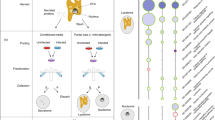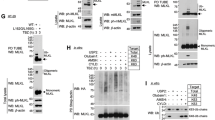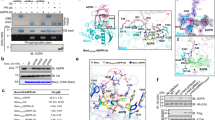Abstract
During infection, pathogenic bacteria manipulate the host cell in various ways to allow their own replication, propagation and escape from host immune responses. Post-translational modifications are unique mechanisms that allow cells to rapidly, locally and specifically modify activity or interactions of key proteins. Some of these modifications, including phosphorylation and ubiquitylation1,2, can be induced by pathogens. However, the effects of pathogenic bacteria on SUMOylation, an essential post-translational modification in eukaryotic cells3, remain largely unknown. Here we show that infection with Listeria monocytogenes leads to a decrease in the levels of cellular SUMO-conjugated proteins. This event is triggered by the bacterial virulence factor listeriolysin O (LLO), which induces a proteasome-independent degradation of Ubc9, an essential enzyme of the SUMOylation machinery, and a proteasome-dependent degradation of some SUMOylated proteins. The effect of LLO on Ubc9 is dependent on the pore-forming capacity of the toxin and is shared by other bacterial pore-forming toxins like perfringolysin O (PFO) and pneumolysin (PLY). Ubc9 degradation was also observed in vivo in infected mice. Furthermore, we show that SUMO overexpression impairs bacterial infection. Together, our results reveal that Listeria, and probably other pathogens, dampen the host response by decreasing the SUMOylation level of proteins critical for infection.
This is a preview of subscription content, access via your institution
Access options
Subscribe to this journal
Receive 51 print issues and online access
$199.00 per year
only $3.90 per issue
Buy this article
- Purchase on SpringerLink
- Instant access to full article PDF
Prices may be subject to local taxes which are calculated during checkout




Similar content being viewed by others
References
Hamon, M. A. & Cossart, P. Histone modifications and chromatin remodeling during bacterial infections. Cell Host Microbe 4, 100–109 (2008)
Rytkonen, A. & Holden, D. W. Bacterial interference of ubiquitination and deubiquitination. Cell Host Microbe 1, 13–22 (2007)
Geiss-Friedlander, R. & Melchior, F. Concepts in sumoylation: a decade on. Nature Rev. Mol. Cell Biol. 8, 947–956 (2007)
Cossart, P. & Toledo-Arana, A. Listeria monocytogenes, a unique model in infection biology: an overview. Microbes Infect. 10, 1041–1050 (2008)
Veiga, E. & Cossart, P. Listeria hijacks the clathrin-dependent endocytic machinery to invade mammalian cells. Nature Cell Biol. 7, 894–900 (2005)
Bonazzi, M., Veiga, E., Cerda, J. P. & Cossart, P. Successive post-translational modifications of E-cadherin are required for InlA-mediated internalisation of Listeria monocytogenes. Cell. Microbiol. 10, 2208–2222 (2008)
Hamon, M. A. et al. Histone modifications induced by a family of bacterial toxins. Proc. Natl Acad. Sci. USA 104, 13467–13472 (2007)
Vertegaal, A. C. et al. Distinct and overlapping sets of SUMO-1 and SUMO-2 target proteins revealed by quantitative proteomics. Mol. Cell. Proteomics 5, 2298–2310 (2006)
Hochstrasser, M. Origin and function of ubiquitin-like proteins. Nature 458, 422–429 (2009)
Nacerddine, K. et al. The SUMO pathway is essential for nuclear integrity and chromosome segregation in mice. Dev. Cell 9, 769–779 (2005)
Hay, R. T. SUMO-specific proteases: a twist in the tail. Trends Cell Biol. 17, 370–376 (2007)
Zhao, J. Sumoylation regulates diverse biological processes. Cell. Mol. Life Sci. 64, 3017–3033 (2007)
Boggio, R. & Chiocca, S. Viruses and sumoylation: recent highlights. Curr. Opin. Microbiol. 9, 430–436 (2006)
Gevaert, K. et al. Stable isotopic labeling in proteomics. Proteomics 8, 4873–4885 (2008)
Saitoh, H. & Hinchey, J. Functional heterogeneity of small ubiquitin-related protein modifiers SUMO-1 versus SUMO-2/3. J. Biol. Chem. 275, 6252–6258 (2000)
Golebiowski, F. et al. System-wide changes to SUMO modifications in response to heat shock. Sci. Signal. 2, ra24 (2009)
Schnupf, P. & Portnoy, D. A. Listeriolysin O: a phagosome-specific lysin. Microbes Infect. 9, 1176–1187 (2007)
Matunis, M. J., Coutavas, E. & Blobel, G. A novel ubiquitin-like modification modulates the partitioning of the Ran-GTPase-activating protein RanGAP1 between the cytosol and the nuclear pore complex. J. Cell Biol. 135, 1457–1470 (1996)
Nato, F. et al. Production and characterization of neutralizing and nonneutralizing monoclonal antibodies against listeriolysin O. Infect. Immun. 59, 4641–4646 (1991)
Michel, E., Reich, K. A., Favier, R., Berche, P. & Cossart, P. Attenuated mutants of the intracellular bacterium Listeria monocytogenes obtained by single amino acid substitutions in listeriolysin O. Mol. Microbiol. 4, 2167–2178 (1990)
Hotze, E. M. et al. Monomer-monomer interactions drive the prepore to pore conversion of a beta-barrel-forming cholesterol-dependent cytolysin. J. Biol. Chem. 277, 11597–11605 (2002)
Boggio, R., Colombo, R., Hay, R. T., Draetta, G. F. & Chiocca, S. A mechanism for inhibiting the SUMO pathway. Mol. Cell 16, 549–561 (2004)
Boggio, R., Passafaro, A. & Chiocca, S. Targeting SUMO E1 to ubiquitin ligases: a viral strategy to counteract sumoylation. J. Biol. Chem. 282, 15376–15382 (2007)
Dramsi, S. & Cossart, P. Listeriolysin O-mediated calcium influx potentiates entry of Listeria monocytogenes into the human Hep-2 epithelial cell line. Infect. Immun. 71, 3614–3618 (2003)
Tang, P., Rosenshine, I., Cossart, P. & Finlay, B. B. Listeriolysin O activates mitogen-activated protein kinase in eucaryotic cells. Infect. Immun. 64, 2359–2361 (1996)
Lin, X., Liang, M., Liang, Y. Y., Brunicardi, F. C. & Feng, X. H. SUMO-1/Ubc9 promotes nuclear accumulation and metabolic stability of tumor suppressor Smad4. J. Biol. Chem. 278, 31043–31048 (2003)
Kang, J. S., Saunier, E. F., Akhurst, R. J. & Derynck, R. The type I TGF-beta receptor is covalently modified and regulated by sumoylation. Nature Cell Biol. 10, 654–664 (2008)
Fitzpatrick, D. R. & Bielefeldt-Ohmann, H. Transforming growth factor beta in infectious disease: always there for the host and the pathogen. Trends Microbiol. 7, 232–236 (1999)
Nakane, A. et al. Transforming growth factor beta is protective in host resistance against Listeria monocytogenes infection in mice. Infect. Immun. 64, 3901–3904 (1996)
Glomski, I. J., Gedde, M. M., Tsang, A. W., Swanson, J. A. & Portnoy, D. A. The Listeria monocytogenes hemolysin has an acidic pH optimum to compartmentalize activity and prevent damage to infected host cells. J. Cell Biol. 156, 1029–1038 (2002)
Dramsi, S. et al. Entry of Listeria monocytogenes into hepatocytes requires expression of inIB, a surface protein of the internalin multigene family. Mol. Microbiol. 16, 251–261 (1995)
Bischof, O. et al. The E3 SUMO ligase PIASy is a regulator of cellular senescence and apoptosis. Mol. Cell 22, 783–794 (2006)
Acknowledgements
We thank V. Villiers for technical assistance. Work in the P.C. laboratory received financial support from Institut Pasteur, INSERM, INRA and European Research Council (ERC, Advanced Grant 233348). We further acknowledge support by research grants from the Fund for Scientific Research – Flanders (Belgium) (project number G.0042.07), the Concerted Research Actions (project BOF07/GOA/012) from Ghent University and the Inter University Attraction Poles (IUAP06). D.R. is supported by a fellowship from the Association pour la Recherche sur le Cancer, F.I. is a Research Assistant of the Research Foundation – Flanders (Fonds Wetenschappelijk Onderzoek – Vlaanderen) and P.C. is an international research scholar of the Howard Hughes Medical Institute.
Author Contributions P.C. planned the project. D.R., K.G., J.V., A.D. and P.C. designed the research, D.R., M.H., E.G., M.-A.N., F.I. and H. N.-K. performed the experiments. D.R., M.H., K.G., J.V. and P.C. analysed the experiments. D.R. and P.C. wrote the paper and co-authors commented on it.
Author information
Authors and Affiliations
Corresponding author
Ethics declarations
Competing interests
The authors declare no competing financial interests.
Supplementary information
Supplementary Information
This file contains Supplementary Figures 1-4 with legends, Supplementary Tables 1-3 and Supplementary References. (PDF 669 kb)
Rights and permissions
About this article
Cite this article
Ribet, D., Hamon, M., Gouin, E. et al. Listeria monocytogenes impairs SUMOylation for efficient infection. Nature 464, 1192–1195 (2010). https://doi.org/10.1038/nature08963
Received:
Accepted:
Issue Date:
DOI: https://doi.org/10.1038/nature08963
This article is cited by
-
HPV-mediated regulation of SMAD4 modulates the DNA damage response in head and neck cancer
Journal of Experimental & Clinical Cancer Research (2022)
-
HrpA anchors meningococci to the dynein motor and affects the balance between apoptosis and pyroptosis
Journal of Biomedical Science (2022)
-
Perturbation of ubiquitin homeostasis promotes macrophage oxidative defenses
Scientific Reports (2019)
-
Mechanisms protecting host cells against bacterial pore-forming toxins
Cellular and Molecular Life Sciences (2019)
-
Listeria monocytogenes: towards a complete picture of its physiology and pathogenesis
Nature Reviews Microbiology (2018)



